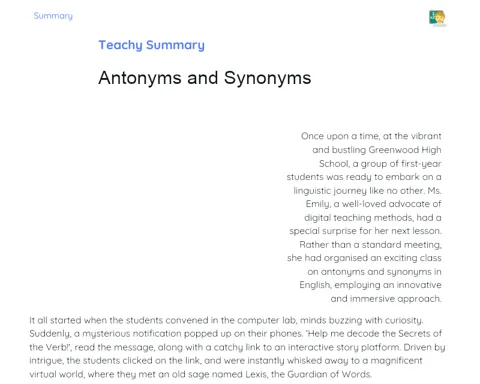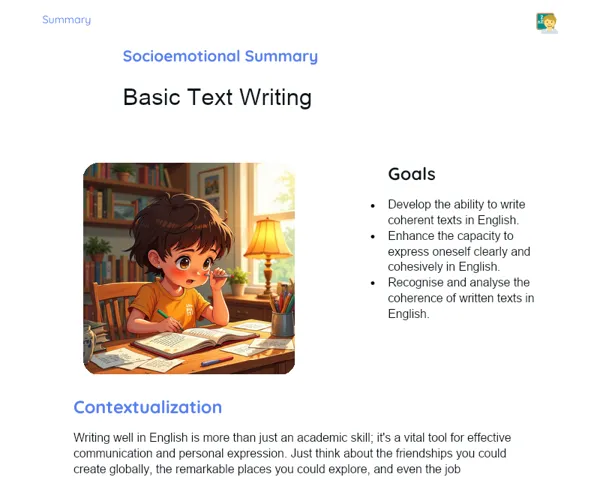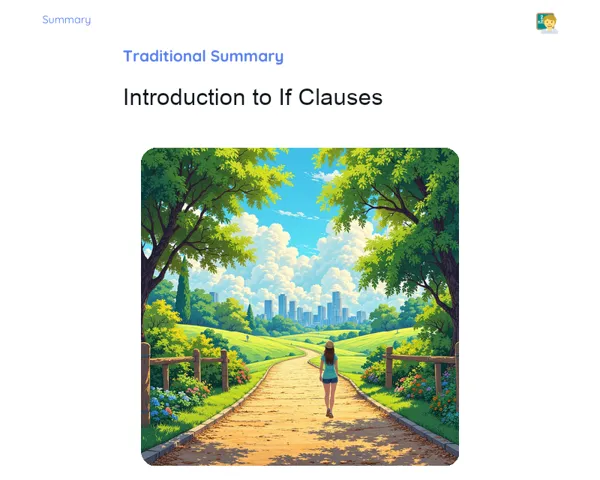Socioemotional Summary Conclusion
Goals
1. Identify the main elements of a text in English, like characters, setting, and plot. 🌟
2. Recognize and interpret the emotions expressed by the characters in the text. 😊
Contextualization
Let’s jump into the wonderful world of stories! 📖 When we dive into a text, we’re not just reading words; we’re exploring new places, meeting fascinating characters, and most importantly, we’re learning to understand their emotions and motivations. This is crucial not just for boosting our reading skills, but also for fostering empathy and awareness about our feelings and how we cope with them. 🚀✨
Exercising Your Knowledge
Characters
Characters are the people, animals, or even fantastical beings that we encounter in a story. They are vital for pushing the plot forward since their actions and feelings shape the narrative. Getting to know the characters helps us connect better with the story emotionally. 🧑🤝🧑🐾
-
Main Characters: These are the protagonists who are central to the plot's development. Example: Harry Potter in 'Harry Potter'.
-
Supporting Characters: They help the main characters and contribute to the story’s progression. Example: Ron Weasley in 'Harry Potter'.
-
Character Development: Following how characters grow and change throughout the story reveals their motivations and feelings. Example: Anakin Skywalker's transformation into Darth Vader.
Setting
The setting refers to where and when a story takes place. It can greatly affect characters' actions and how the plot unfolds. Understanding the setting enriches our reading experience by providing context for the characters' emotions and actions. 🌍🏞️
-
Location: The place where the story is set, which could be a bustling city or a mystical forest. Example: Hogwarts in 'Harry Potter'.
-
Time: When the events occur, be it in the past, present, or future. Example: The 80s in 'Stranger Things'.
-
Influence on the Plot: The setting has the potential to shape events and characters' behaviours. Example: The jungle in 'The Jungle Book'.
Plot
The plot is the sequence of events in the story that includes the introduction, rising action, climax, and resolution. Understanding the plot structure is key to following the story and noticing how characters’ emotions evolve. 📈📉
-
Introduction: Sets up the characters and the setting, laying the groundwork for the story. Example: Harry Potter's arrival at Hogwarts.
-
Development: Where the main events and conflicts start to occur. Example: The trials Harry faces during his time at Hogwarts.
-
Climax: The most intense moment where the conflict peaks. Example: The ultimate showdown between Harry and Voldemort.
-
Conclusion: Resolving conflicts and wrapping up the story. Example: The epilogue in 'Harry Potter and the Deathly Hallows'.
Themes
Themes are the key ideas or messages within a story. They can be directly stated or subtly woven throughout the narrative and often reflect universal issues that resonate with readers. Understanding the themes can provide deeper insight into the reading experience. 🖤
-
Explicit: Clear themes that are overtly present in the story. Example: Friendship in 'Harry Potter'.
-
Implicit: Themes that readers need to infer. Example: Sacrifice in 'Harry Potter'.
-
Relevance: Themes make the story engaging and relevant, linking it to the reader's personal experiences. Example: Personal growth in 'The Lord of the Rings'.
Conflict
Conflict refers to the challenges or problems that characters encounter, which can be internal (inside the character) or external (between characters or with the environment). Conflict is crucial for plot development and for shaping the characters’ emotions. 💥
-
Internal: Such as moral dilemmas faced by characters. Example: Frodo's battle with the Ring's power in 'The Lord of the Rings'.
-
External: Conflicts between characters or against the setting. Example: The fight between Harry and Voldemort in 'Harry Potter'.
-
Resolution: How the conflict is resolved, often leading to the story’s climax. Example: The destruction of the Ring in 'The Lord of the Rings'.
Character Emotions
Recognizing the emotions characters experience at various moments in the story is key to developing our empathy and emotional intelligence. Emotions are what drive the story and help us forge personal connections with the characters. 😊😢
-
Recognition: Identifying and labelling the emotions felt by characters. Example: Simba’s despair after losing his father in 'The Lion King'.
-
Causes: Understanding what triggers the characters’ emotions. Example: The rivalry and challenges in 'The Hunger Games'.
-
Consequences: Observing how these emotions impact the characters' decisions. Example: Katniss's determination to survive.
Key Terms
-
Text Interpretation: The process of understanding and explaining a text's meaning.
-
Characters: The individuals in the story driving the plot with their actions and emotions.
-
Setting: The time and place where the story unfolds.
-
Plot: The series of events that make up the story.
-
Themes: The main ideas or messages conveyed by the story.
-
Conflict: The challenge or issue faced by the characters.
-
Character Emotions: The feelings experienced by characters throughout the story.
For Reflection
-
How do you feel when you recognize the emotions of characters in a story? How does this enhance your own self-awareness? 🤔💭
-
Think of a time when you faced a conflict. How did you resolve it, and how is it similar to what the characters in the story dealt with? 🔄⚔️
-
What was the last story you read where you formed a strong connection with a character? How did understanding that character's emotions help you manage your own feelings? 📖❤️
Important Conclusions
-
- We identified the main elements of a text in English, like characters, setting, and plot. 🌟
-
- We learnt to recognize and interpret the emotions expressed by the characters in the text. 😊
-
- We discovered how the various elements of a story connect and influence each other. 🔗
-
- We reflected on how interpreting texts can help us develop empathy and social awareness. 🗺️
Impacts on Society
Today, the ability to interpret texts is more essential than ever. We are constantly bombarded with information, from social media to classroom materials. Learning to interpret texts enables us to discern what matters, grasp different perspectives, and make informed choices. 📖💡 Additionally, by understanding the emotions and motivations of characters, we cultivate empathy, a crucial social skill for building meaningful relationships and better understanding others. 🌈🤝 Text interpretation is not just an academic skill; it’s an essential life skill that enables us to connect with stories and the people around us. 💖 The lessons gleaned from characters' challenges can inspire us in managing our own conflicts and emotions, paving the way for a kinder and more empathetic community. 🌍🤗
Dealing with Emotions
🌈 For this home exercise, you'll put the RULER method into practice! First, recognize the emotions you feel while reading a text. Is it curiosity, joy, frustration? Then, understand what causes these emotions. What in the text triggered those feelings? Name these emotions accurately: sadness, happiness, irritation. Express how you feel in a constructive way — perhaps through journaling or drawing. Finally, regulate these emotions; if something upset you, try to calm down by taking deep breaths or chatting to a friend. ✍️😊
Study Tips
-
🔍 Read actively: As you go through a text, underline or jot down important sections like key characters and plot changes. This helps you stay focused and remember details.
-
💬 Chat with friends: Discussing what you’ve read with friends or family can open up new perspectives and deepen your understanding of the characters’ emotions.
-
📖 Summarise: After finishing a text, write a quick summary in your own words. This reinforces your learning and helps embed the information in your memory.



